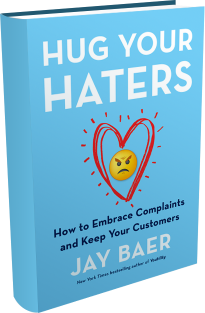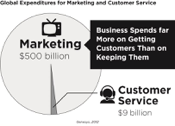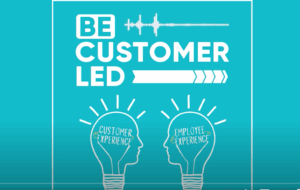Guest post by Jay Baer (@jaybaer), author of the new book, Hug Your Haters: How to Embrace Complaints and Keep Your Customers,
Let‘s face it: choosing whether or not you hug your haters isn‘t about you knowing how to do so, it‘s about whether doing so aligns with the values of your business.
The great paradox
Every company says that customer satisfaction is their most important objective, yet their actions demonstrate otherwise. It‘s a paradox, but I find companies that feel the need to make public statements about customer experience being important are usually the companies where that clearly is not the case.
It‘s like what my former colleague, the advertising executive Roger Hurni, told me about Applebee‘s restaurants: “If you have to use your tagline to tell people you‘re the neighborhood bar and grill, you‘re definitely not the neighborhood bar and grill.”
Joe Gagnon is Senior Vice President at Aspect, a company that helps large corporations improve customer service with software and optimization services. He says some companies simply do not prioritize satisfied customers, and have no qualms about it. “In the few cases when the cost of customer acquisition is lower than the cost of retention, there is almost a disincentive to customer satisfaction.”
Gagnon relayed a quote from a fast food franchise operator who told him, “I don‘t really care about customer satisfaction. I just want them to serve them food and have them pay me.”
As a consumer, when you encounter the opposite, a business that really and truly puts customer first, they don‘t even have to tell you it‘s so, because you can feel it. These are the company cultures where delivering a great customer experience is baked in at the molecular level.
In an instant, you can probably name five or 10 local or national companies that always make you feel like a valued customer. It‘s not a coincidence that those companies are also often great at customer service, and committed to hugging their haters.
We can easily name customer experience cultures because they are rare. Their scarcity contributes mightily to their memorability. These companies are exceptional, in the truest definition of the word.
The financial impact of customer focus is massive
And the financial impact of a focus on customers is massive. A five percent increase in customer retention boosts profits by 25 to 85 percent. That‘s not a new discovery; it was published in a Harvard Business Review case study in 1990. So, we‘ve known that a focus on customer experience makes sound business sense for 25 years or more, but the companies that execute on it are still outliers. Why?
Your customer journey is driven from the top down
“You know how they say, “The fish rots from the head?” Your customer journey is driven from the top down. This is absolutely a cultural thing. There is not a problem in the world that can‘t be solved technologically, but the best technology is going to do nothing for you unless you have a culture of customer excellence,” says Michael Maoz of Gartner. Jet Blue airlines has such a culture, as evidenced by a story told by social media customer service manager
Laurie Meacham about a passenger who had been tweeting before her flight. According to Meacham, the passenger was not tweeting at Jet Blue directly but just tweeting in general. It was obvious from her previous tweets that she had been having a rough time in life. Her last tweet before boarding was “I‘m so looking forward to getting the Pop Chips.” Jet Blue usually serves free snacks on flights, and Pop Chips are a customer favorite. Unfortunately, the plane was out of Pop Chips and the passenger tweeted her disappointment, using the in-air Wi-Fi connection.
This is a classic example of indirect haters, those hidden complainers that most companies never find, much less act upon. “She wasn‘t really talking to us or complaining to us,” say Meacham. “This was just her narrative. So we packaged up a box of Pop Chips with a little note and we mailed it to her home. She sent a tweet a few days later with a photo saying ‘Look at what Jet Blue sent me!’ It was our way of sort of making up for it. And, you know, sometimes it‘s better to take things offline.”
Go “off-script”
Meacham emphasizes that none of these beyond-the-norm interactions require permission from multiple people at Jet Blue, where working “off-script” is valued far more than adhering to the script. “It‘s exactly these sort of spontaneous things that we want to empower our team members to recognize. They just find them, and act on them,” she says.
Martin Shervington from Plus Your Business calls this the culture of “sincere hospitality” and notes there are obvious attributes of companies that have this culture. Everyone in the organization feels like they are in customer service, even if they aren‘t specifically assigned those duties. All team members are empowered to solve a customer‘s problem, at any time, the way they are at the Ritz-Carlton hotel chain and other customer-focused brands. Even executives or owners interact with customers themselves.
You might think it‘s easier for small business owners to connect with customers than it is for large company executives, and you‘re right. But it‘s by no means impossible for executives to talk to customers in a big organization; you just have to want to do it badly enough. Pella Windows and Doors wants to do it, and does.
“Our founder, Pete Kuyper, who got this company going 90 years ago, always thought that the best thing you can do is to take care of the customers and there are numerous stories about him bending over backwards to take care of things. That‘s always been part of our DNA,” says Pella Vice President of Marketing, Elaine Sagers.
“Monthly, our executives call a random selection of unhappy customers to talk about their experience with us. Sometimes it can be really painful because it‘s often simple stuff that goes wrong,” she said. “We now start every one of our monthly business meetings (a meeting with the most senior leaders in the company) with a good customer letter and a bad customer letter. We‘ve also played recordings from the call center so you can hear the emotion in our customers‘ voices around what‘s been happening with their jobs and their homes.”
The large tax preparation company Jackson Hewitt has also embraced customer experience and involved their senior executives as well. “Dave Prokupek came on board as CEO in 2014 and he has a fierce passion for the customer, and for the customer being happy and being heard,” says Vada Hill, Jackson Hewitt‘s Chief Marketing Officer.
Actually talk to your customers
“I‘m a big believer in that‘s an important part of my job that I reach out to customers. I call customers on the phone. In executive discussions I‘ve printed out the Facebook accounts of certain customers who were not being served well, with an eye towards putting a face to an unhappy customer. I think that it‘s really important that as an executive team we are sensitized to the people behind the complaints. These are real people, these are people on whom our livelihood as a business depends, and it‘s very important that we meet their needs and that they feel that they‘ve been heard,” Hill explains.
Put a face to your unhappy customers
If you‘re going to embrace customer experience and hug your haters, it certainly helps to have an executive team that believes in sincere hospitality, as do Hill, Sagers, and their respective CEOs. It also helps if the company puts their money where their mouth is, and most simply do not.
In nearly all companies (but perhaps not in businesses focused first on customer experience), resources are disproportionately expended on getting customers, not keeping them.
Globally, 500 billion dollars each year are invested in marketing, compared with just 9 billion dollars in customer service. That means customer service has less than 1/50th the budget of marketing. Katy Keim from Lithium describes the gap this way, “Marketing has the funding, but not the capabilities. Customer service has the capabilities but not the funding.”
One of the ways to close that gap is to constantly prove the value of service and complaint resolution, a measurement imperative that has bedeviled the customer experience industry for years.
Carine Clark, the President and CEO of MaritzCX, says the metrics problem is finally being fixed: “Customer experience (CX) programs in the past were missing a critical element—a measurable impact on business outcomes. It was almost as if these programs were a ship without a rudder, aimlessly delivering scores, data and statistics to bewildered employees and busy executives,” she says. But today‘s programs are different. Their direction is set by strong, visionary strategies that focus on outcomes. Today‘s programs directly impact the most relevant boardroom measurements: customer retention, revenue growth, profitability and employee loyalty. Business leaders and employees inherently understand that improving the customer experience makes sense. On a logical level, it really is the baseline for every business: making customers happy. Often business leaders get distracted, thinking that their business is something else, like design, pricing, presentation or quality. These are all previews to the real show, customer retention based on the overall customer experience.”
Commit
Clark is right. A commitment to customer experience keeps customers and grows revenue. But measuring that relationship can be time-consuming and expensive, which is why so many customer service and customer experience programs use other data points as surrogates for financial gain. These include metrics like Net
Promoter Score, which charts the likelihood of customers to recommend the business to a friend or colleague. Net Promoter Score methodology was also the basis for how we measured the customer advocacy impact of answering complaints among offstage and onstage haters when we conducted the research for this book. Other businesses chart total number of customer interactions, per channel, which is how KLM and Microsoft Xbox know precisely how many tweets they answer each week.
For many years, customer service organizations that were primarily focused on telephone interactions charted their “handle time,” the time needed to answer the phone and bring the issue to a close. This feels like an anachronism in today‘s world, where customers expect a quick response across many channels. Discover Card, Jackson Hewitt, and KLM pay close attention to this “response time” and use it as a key success measure, rather than handle time.
Customer experience architect Esteban Kolsky doesn‘t believe either measure is sufficient, and that we should be tracking “resolution time” because it represents what the consumer really wants and needs.
Deliver more value
“It‘s about answers. People want answers and an answer equals value. The faster, better and more complete, more accurate answer that you deliver, the more value you deliver. That‘s what it comes down to. So figure out what‘s the best to deliver the best answer, via the best way possible at the right time. That‘s value to the customer,” he says.
Joe Gagnon believes the best measure is “customer effort.” “What customer service is really about, and what we try to do at Aspect, is connect questions to answers,” he says. “And we should be measuring how easy (or difficult) it is for the customer to get that answer,” he says. If it‘s easy enough, you‘ll start to see it emerge in customer comments like, ‘I can‘t believe how easy that was.’”
Surveys are one of the other systems used by both small and large businesses to gauge the effectiveness of their customer service. You no doubt have received requests to provide feedback through a survey, often “invited” (like it‘s a party with an open bar) to participate via an email blasted to you after your most recent transaction with a business.
I make it a habit to answer these requests to complete surveys. Whether I‘m asked to rate my recent chicken wing experience, or grade my local car dealership, I‘m happy to oblige because I find these surveys fascinating. I also find them to be almost universally terrible.
Surveys: a customer satisfaction crime scene
Not long ago, I had a poor experience at a Las Vegas casino hotel. I don‘t want to tell you which one, but it has an enormous lion at the front entrance. I received a standard email blast with a link to the post-stay survey. Eager to share my thoughts, I clicked to open the survey and discovered a customer satisfaction crime scene.
The survey was more than 60 pages long and took more than 40 minutes to complete. Only at the very end did the hotel ask for my actual feedback, and even then it was in a truncated and perfunctory fashion. What did the other 50-plus survey pages contain? Question, after question, after question about marketing and Las Vegas strip competitors. “What restaurants did you visit on our property?” they asked, followed by an enormous list. “What restaurants did you visit elsewhere in Las Vegas?” they asked next, followed by a list that dwarfed the first one.
This is not customer service measurement. This is not embracing customer feedback. It‘s marketing and market research. There are many times and places where those questions and conversations are appropriate. The first 75 percent of a guest satisfaction survey is not one of those times.
Beyond their wholly soulless nature that lacks a shred of humanity or nuance, the issue with surveys is where the results go and how they are used. It‘s entirely possible one or more surveys are being sent to your customers at this very moment. Who has access to the results? How is that information used? Are trends charted? Are summaries provided on a regular basis to the customer service and operations teams? Are key findings presented to executives for discussion, as is the case at Pella and Jackson Hewitt?
If you‘re going to make use of surveys, make use of the data they capture. Otherwise, you‘re just setting up a false expectation among your customers that you are listening, when in reality you‘re deflecting.
We‘ve seen that a customer experience culture with a commitment to sincere hospitality requires leadership from owners and/or senior executives. It also requires resources, as hugging your haters isn‘t an inexpensive proposition. You need relevant measurement and metrics, as well.
Say “I’m sorry”
The last thing you need is permission to say you‘re sorry. And that‘s not a given, especially in big companies.
Frank Eliason has seen it first hand “One of the first unofficial rules often taught to customer service professionals in large companies is the inability to say ‘I‘m sorry.’ Management instructs that saying ‘I am sorry’ is somehow admitting fault. Always remember that how you communicate to your employees sends a message. Sometimes that message may be about risk, other times it could be about profits; the way that the message is received will impact how you treat your customers, even if it was never intended to be that way.
In some corners of the business universe, anyone interacting with customers is prohibited from saying (or typing) an apology, because it is believed by particularly draconian attorneys that it could weaken the company‘s position in a legal proceeding. I am not a lawyer, but that feels wrong to me. Dave Kerpen (also not a lawyer) feels the same, “Attorneys might not love the words ‘I‘m sorry,’ but the reality is, ‘I‘m sorry’ is not an admission of liability, it‘s a declaration of empathy,” he says.
I like the concept of “declaration of empathy” but is there legal justification to the idea of never saying “I‘m sorry?”
“In the words of George Bernard Shaw, ‘If that‘s the law, then the law is an ass,’” says Michael Lasky, an attorney and litigator with the Davis & Gilbert law firm in New York City.
Lasky specializes in public relations, advertising, and e-commerce law. “Any notion that ‘I‘m sorry’ is an admission of liability is far too simplistic and is definitely an overreaction. Should companies be careful about what they say, especially in a public forum? Sure. But I don‘t think the answer is simply you can ever respond to negative complaints, and you can never say ‘I‘m sorry.’
Some businesses won‘t allow their representatives to say “I‘m sorry,” but they certainly will allow their representatives to tell the customer “no.” If you start to pay attention to how often you say “no,” whether due to “policy” or some other reason, the results can be staggering.
Ameriprise Financial, for example, asks its customer service representatives to capture every instance in which they are forced to tell a customer no. While auditing the “no‘s,” the company found many legacy policies that had been outmoded by regulatory changes or process improvements. During its first year of “capturing the no‘s,” Ameriprise modified or eliminated 26 policies. It has since expanded the program by asking frontline customer service agents to come up with other process efficiencies, generating $1.2 million in savings as a result.
Like with all relationships, showing you care means the little things are the big things. And the big things are the big things. Ask the right questions. Answer feedback. Develop a culture of customer care. As Ameriprise and so many other companies demonstrate, the results can be as staggering as they are inspiring.
Drawn from Hug Your Haters: How to Embrace Complaints and Keep Your Customers, about which Guy Kawasaki says: “This is a landmark book in the history of customer service.” Written by Jay Baer, Hug Your Haters is the first customer service and customer experience book written for the modern, mobile era and is based on proprietary research and more than 70 exclusive interviews.







Hi Jay, I like your blog because it’s really interesting and I do learn a lot. Nice notes on commitment and putting face to your customers. For me, that’s how any company should act if they want their brand to last.
In every business, we should never forget who helps us make money. Thank you for sharing this article. Very informative!
Thanks for some other wonderful article. Where else could anyone get that kind of
information in such an ideal approach of writing? I’ve a presentation next week, and I’m on the look for such information.
If you ask from digital perspective; check out customer recency and bounce rate your portal; these 2 metrics will be enough to identify your customer satisfaction.
Actually, every company and business needs its haters. Why? They are the only ones who really make the company grow, improve its services and strive to meet customers needs. The haters are those who can show you weak sides and can tell what else to be improved. So, pay much more attentin to those who have negative experience from your interaction.